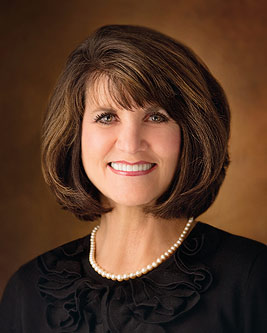In the April 2013 General Conference of The Church of Jesus Christ of Latter-day Saints, whose members are nicknamed Mormons, a woman gave the closing prayer in the first session. Jean A. Stevens is the First Counselor in the General Primary Presidency, which means she assists the president and the second counselor in overseeing the children’s auxiliary internationally. Women have given all the prayers in the Young Women and Relief Society sessions held shortly before conference weekend. Prayer assignments have followed patterns. Until this weekend, assignments have most recently been given by members of the Seventies, and since this is a priesthood office, the people giving the prayers have been men. Prior to this, prayers were given by newly released mission presidents. Assignments have nearly always been based on holding a specific office, not actually based on gender, although it has worked out that way—but the purpose was not to give the role only to men.
 Throughout the Bible, we note that practices regularly change. Each prophet brought new practices to the church—for instance, the Law of Moses was replaced by Jesus Christ and a revelation given to Peter ended the practice of not taking the gospel to the gentiles. The same revelation also ended the requirement of circumcision. Recently, Mormons lowered the age of missionary service. These were not eternal truths. They were merely practices that had been designed to meet the needs of a given time and people.
Throughout the Bible, we note that practices regularly change. Each prophet brought new practices to the church—for instance, the Law of Moses was replaced by Jesus Christ and a revelation given to Peter ended the practice of not taking the gospel to the gentiles. The same revelation also ended the requirement of circumcision. Recently, Mormons lowered the age of missionary service. These were not eternal truths. They were merely practices that had been designed to meet the needs of a given time and people.
While practices can change, eternal truths do not. These are sacred and are based on important gospel truths that can never change, any more than we can decide to change the law of gravity. Prayer assignments are practices, not eternal truths, and can therefore be changed. However, the current story, offered with no sources and without meeting the guidelines of the Associated Press for the use of anonymous sources, has not yet been verified. Scott Trotter, the Mormons’ official spokesman, said prayer assignments were made at the end of last year, although they can be changed and occasionally are. He neither confirmed nor denied the rumor.
If women do pray, it will not mean the Mormons are evolving on the subject of women in the Church. It will not lead to ordination of women, since we can see from the Bible that the priesthood is assigned to men. When the priesthood was introduced in the Old Testament, it was given only to men. When Jesus chose His apostles, He chose only men. The twelve men listed in the Bible, as well as the twelve listed in the Book of Mormon for that region of the Church, were men. An apostle, although called to be a special witness of the resurrected Christ, must also be called and ordained. Merely seeing the Savior is not enough to make one an apostle.
Mormon women—and in fact, Mormon men—have more opportunities to do the work of an ordained minister than most people in other churches. While in most faiths, you must be an ordained minister to lead the prayer in the worship service, anyone can do so in a Mormon service. One person is invited to give the opening prayer and one the closing prayer each service, chosen usually that day before the service. Anyone age twelve or older, male or female, can give the sermon, and once a year, even children as young as three do so. Meetings have several short sermons and so most Mormons give a sermon once a year or so.
Because Mormons have a lay ministry, all the work is done by unpaid volunteers and there is more than enough work to keep everyone busy. Nearly everyone has a calling, which is what Mormons call this work. Many have more than one.
Some callings can be held by any adult. Others are assigned to specific genders. While there are callings women may not hold, there are also callings men may not hold. Some callings held by men are overseen by female leaders. As an example, the literacy program can only be led by a woman, the literacy leader, and she is supervised by the Relief Society president, who is also a woman. However, men may serve as literacy instructors, even though they are not permitted to lead. This is not because men are not capable of leading a literacy program. It’s simply not their assignment.
The Relief Society president, always a woman, carries out nearly all the duties a minister in another faith might do. She manages a budget and oversees the education program for Mormon women (and for men in the case of literacy). She makes policy decisions, supervises teachers and leaders, has a staff, and does much of the humanitarian work of the congregation. She participates with the bishop in helping people suffering from food insecurity issues. Because she is a woman, she is often the confidante of choice for many women seeking counseling. She visits women in their homes and ensures that all Mormon women receive a home visit from someone each month to find out if they need anything. All these are duties normally carried out by ministers in other churches.
Mormon women have more ways to serve and to lead than they have in any other church, and may do so without choosing the ministry as a profession. Nearly every woman in the church will receive opportunities to preach, pray, and lead. The goal for a practicing and believing Mormon woman is to serve God in any way He asks her to serve. It isn’t how we serve, but why, that matters in the eternal scheme of things.
About Terrie Lynn Bittner
The late Terrie Lynn Bittner—beloved wife, mother, grandmother, and friend—was the author of two homeschooling books and numerous articles, including several that appeared in Latter-day Saint magazines. She became a member of the Church at the age of 17 and began sharing her faith online in 1992.





